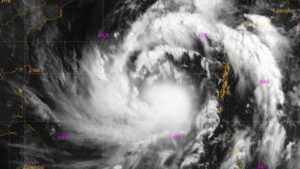Cyclone Asani
Context:
• Severe cyclonic storm Asani packing gale-force winds up to 120 kmph which is moving towards the east coast bringing along heavy rain, is likely to recurve in a north-northeastward direction on reaching near the shore and weaken gradually into a cyclonic storm.


How are the cyclones named?
• Bangladesh, India, Maldives, Myanmar, Oman, Pakistan, Sri Lanka, and Thailand formed the WMO/ESCAP (World Meteorological Organization/United Nations Economic and Social Commission for Asia and the Pacific) group in 2000 to begin naming cyclones in the region.
• The WMO/ESCAP Panel on Tropical Cyclones (PTC) finalised the list after each country submitted comments.
• In 2018, the WMO/ESCAP welcomed five new members: Iran, Qatar, Saudi Arabia, the United Arab Emirates, and Yemen.
• Tropical cyclones in the Atlantic and Southern Hemisphere (Indian Ocean and South Pacific) are given names in alphabetical order, with women and men’s names alternated. In the year 2000, nations in the northern Indian Ocean adopted a new system for naming tropical cyclones.
About:
• Tropical cyclones are strong storms that form over tropical waters and then travel inland, wreaking havoc with violent winds, heavy rainfall, and storm surges.
• Tropical cyclones are one of the world’s most destructive natural disasters.
• Tropical cyclones form over warm tropical oceans and intensify.
The following are favourable conditions for tropical storm creation and intensification:
• A large area of sea surface with a temperature above 27° C.
• Large sea surface with temperature higher than 27° C.
• Presence of the Coriolis force.
• Small variations in the vertical wind speed.
• A pre-existing weak low- pressure area or low-level-cyclonic circulation.
• Upper divergence above the sea level system.
Source: THE HINDU.
For more update, click here to join our telegram channel




